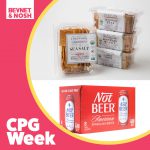Kerry Looks to Clean Label Report to Shape Future Innovations

In the battle to attract consumers to clean label products, it’s about more than just ingredient certifications and claims.
That’s what Irish global ingredient supplier Kerry Group found out as the result of research into labeling as the company tries to shape strategies that will guide its plans for customers’ innovation pipelines.
Last week, Kerry released “Beyond The Label,” a white paper examining consumer preferences regarding clean label food and beverages. Kerry brand manager Jordan Miller told NOSH that the paper is aimed at optimizing ingredient profiles for consumers while also finding the best path to growing its organic offerings across categories and channels.
“We are really kind of using this research as a tool to help us guide customers so that the faster they can get clarity over what consumers are looking for, the more successful that everyone will be,” Kerry brand manager Jordan Miller said. “It also helps our own internal developments to make sure we are setup to deliver on what the needs of those brands are.”
Across all categories, as a result of the research, Kerry will focus on aligning its products with three pillars: better ingredients, added nutrition and eco-friendly products. The research, conducted in 2017, is based on responses from 2,500 shoppers; 702 of them were American consumers.
Though skeptical consumers do actively seek out on-pack marketing claims or certifications, for many consumers, Kerry found that the ingredients themselves are most important. The report notes that currently about 75 percent of American consumers surveyed indicated they evaluate ingredients on package, while 66 percent look at the nutritional panel.
When it comes to ingredients, the report measured consumer perceptions about 54 specific ingredients to understand how “unacceptable” ingredient” standards vary across generations. Regardless of category, Kerry saw some similarities in the ingredients all consumers wish to avoid — such as high-fructose corn syrup, titanium dioxide and MSG — and general ingredient concerns, such as added sugar levels. Almost 15 percent of millennials also deemed ‘natural flavors’ as unacceptable in savory snacks, though less than five percent of Boomers felt they were unacceptable.
But just as the presence of certain ingredients can be red flags, so can the absence of others. The report found that American consumers most frequently look to nutrition-boosting ingredients like protein and probiotics.
“It took a while for us to identify exactly those that matter most to consumers… we realized ingredients [were] a big focus, but there was definite attention in nutrition and sustainability,” lead researcher on the report, Soumya Nair, told NOSH.“Consumers aren’t just looking at the elimination of ingredients, but also the addition, so that was also an eye opener for us.”
These findings influenced Kerry’s most recent acquisition: probiotic ingredient supplier Ganeden. Ganeden’s portfolio of ingredients will now fall under the Kerry umbrella, along with the previous acquisition of Wellmune, a yeast-derived food and beverage ingredient designed to enhance the immune system. Nair said the report’s findings will continue to shape what the company looks for in future acquisitions.
As for certifications, sustainability is a claim that is more important to all consumer types than it ever has been before. Researchers also found that customers are looking for claims like all-natural and locally produced/ grown. Over half of surveyed consumers said their beliefs regarding a product’s sustainability was attributed to ethical manufacturing practices, eco-friendly products, responsible sourcing and ethical farming practices, according to the report, with another 33 percent attributed to an assumption that eco-friendly products are healthier (using ingredients that were organic, non GMO, etc.) and longer lasting.
For brands, embracing these demands can sometimes result in price increases, the result of using more expensive ingredients. But according to the report, 75 percent of consumers, and 88 percent of millennial consumers, indicate they are willing to pay more for food with a cleaner label.
Still, even though consumers may be moving in the direction of embracing clean label products, they aren’t willing to sacrifice their guilty pleasures.
“The more impulse, pleasure, social aspects that come in, we see these consumer expectations leaning a little bit when it comes to ingredients and clean label,” Nair said. “If it is an indulgent item — something as simple as a can of Coke — people forget about clean label, they forget about nutrition. They are willing to make that trade off for taste.”
Nair added that she thinks focusing on taste is the best way to overcome some consumers hesitations across channels and categories.
“When consumers are saying ‘I’ll bite the bullet, spend a little bit more and go out of my way to purchase food at a natural food grocer,’ when the taste doesn’t meet expectations, you lose your association with the consumer,” she said. “The best thing for brands right now is to focus their attention on solving for taste rather than just removing a lot of the ingredients… You need to solve for taste because at the end of the day that is why your consumer is buying your product.”













